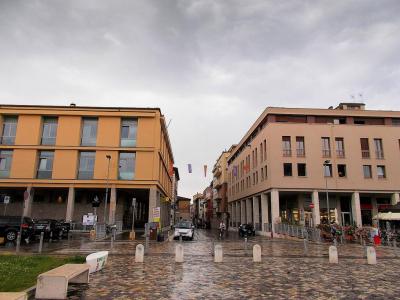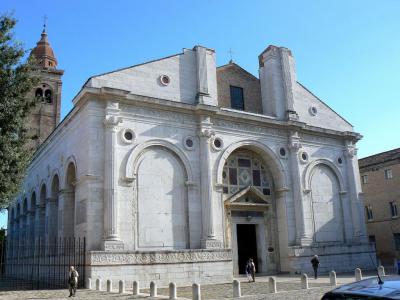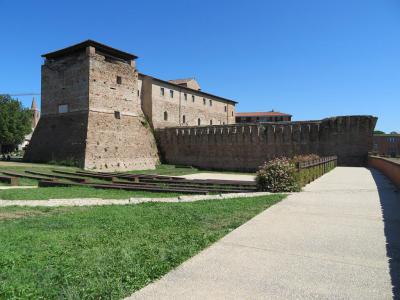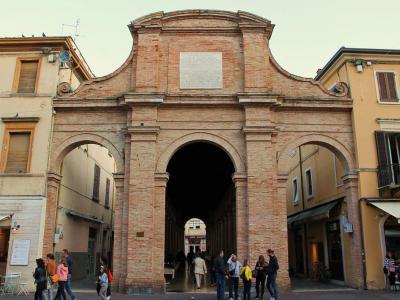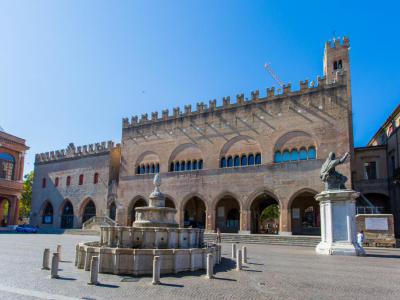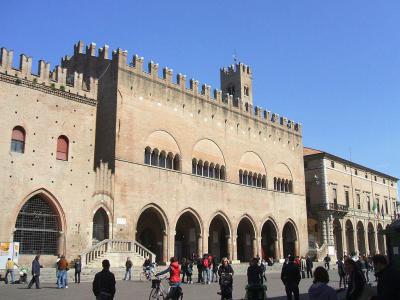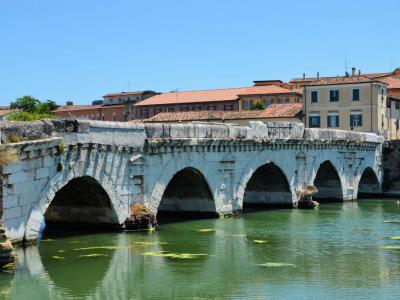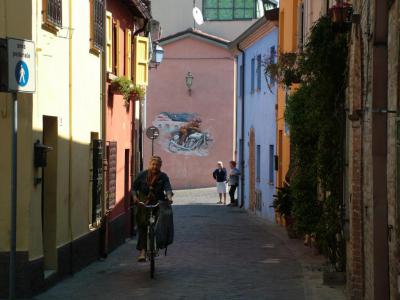
Rimini Introduction Walking Tour (Self Guided), Rimini
The Roman Republic founded an outpost called Ariminus at the mouth of the river Marecchia in 268 BC. Rimini was a center of civil wars and invasions. Julius Caesar made his famous "Rubicon" speech to his troops in the city forum.
The city was an all-important junction. The ancient Roman road, via Flaminia, ended in Rimini at the Arch of Augustus, erected in 27 BC. Another old Roman road, via Aemilia, connected Rimini with the town Piacenza on the river Padus. A Roman amphitheater that held 12,000 is still visible today, and the five-arched Bridge of Tiberius (built in 21 AD) is still in use.
In the 13th and 14th centuries, the city was dominated by the dynasty of Malatesta. The most powerful scion was Sigismondo Pandolfo Malatesta, a renowned military commander and lord of Rimini. He built the Malatestiano Temple and fought for the independence of the city.
Rimini has a varied architectural legacy. The Arch of Augustus, the Bridge of Tiberius, the Amphitheater, and the House of the Surgeon are Roman. The Arengo Palace, the Church of Saint Agostino, and the Sismondo Castle are prominent examples of the Middle Ages and the Renaissance.
The city's districts carefully preserve buildings of the Neoclassical, Art Nouveau, and Art Deco periods. Augustus Street is the Main Street of the Old City center, leading to the historic squares of Rimini. Three Martyrs Square houses shops and cafes, while Piazza Cavour has the Old Fish Market and an exciting nightlife.
Rimini is the hometown of Federico Fellini. His name is everywhere. The Fellini Museum, located in the Valloni Palace, the "Square of Dreams," and the medieval Rocca Malatestiano sparkles with interactive installations from his life and films.
Fellini once said, "Life is a combination of magic and pasta." Rimini provides the food, while Fellini provides the magic. A Rimini itinerary should include pasta dishes found only in Rimini. Dishes like passatelli or a flatbread piada filled with arugula and spreadable squacquerone cheese. Magic and food and history. Come to Rimini.
The city was an all-important junction. The ancient Roman road, via Flaminia, ended in Rimini at the Arch of Augustus, erected in 27 BC. Another old Roman road, via Aemilia, connected Rimini with the town Piacenza on the river Padus. A Roman amphitheater that held 12,000 is still visible today, and the five-arched Bridge of Tiberius (built in 21 AD) is still in use.
In the 13th and 14th centuries, the city was dominated by the dynasty of Malatesta. The most powerful scion was Sigismondo Pandolfo Malatesta, a renowned military commander and lord of Rimini. He built the Malatestiano Temple and fought for the independence of the city.
Rimini has a varied architectural legacy. The Arch of Augustus, the Bridge of Tiberius, the Amphitheater, and the House of the Surgeon are Roman. The Arengo Palace, the Church of Saint Agostino, and the Sismondo Castle are prominent examples of the Middle Ages and the Renaissance.
The city's districts carefully preserve buildings of the Neoclassical, Art Nouveau, and Art Deco periods. Augustus Street is the Main Street of the Old City center, leading to the historic squares of Rimini. Three Martyrs Square houses shops and cafes, while Piazza Cavour has the Old Fish Market and an exciting nightlife.
Rimini is the hometown of Federico Fellini. His name is everywhere. The Fellini Museum, located in the Valloni Palace, the "Square of Dreams," and the medieval Rocca Malatestiano sparkles with interactive installations from his life and films.
Fellini once said, "Life is a combination of magic and pasta." Rimini provides the food, while Fellini provides the magic. A Rimini itinerary should include pasta dishes found only in Rimini. Dishes like passatelli or a flatbread piada filled with arugula and spreadable squacquerone cheese. Magic and food and history. Come to Rimini.
How it works: Download the app "GPSmyCity: Walks in 1K+ Cities" from Apple App Store or Google Play Store to your mobile phone or tablet. The app turns your mobile device into a personal tour guide and its built-in GPS navigation functions guide you from one tour stop to next. The app works offline, so no data plan is needed when traveling abroad.
Rimini Introduction Walking Tour Map
Guide Name: Rimini Introduction Walking Tour
Guide Location: Italy » Rimini (See other walking tours in Rimini)
Guide Type: Self-guided Walking Tour (Sightseeing)
# of Attractions: 12
Tour Duration: 2 Hour(s)
Travel Distance: 2.4 Km or 1.5 Miles
Author: Dara
Sight(s) Featured in This Guide:
Guide Location: Italy » Rimini (See other walking tours in Rimini)
Guide Type: Self-guided Walking Tour (Sightseeing)
# of Attractions: 12
Tour Duration: 2 Hour(s)
Travel Distance: 2.4 Km or 1.5 Miles
Author: Dara
Sight(s) Featured in This Guide:
- Arco di Augusto (Arch of Augustus)
- Corso d'Augusto (Augustus Street)
- Piazza Tre Martiri (Three Martyrs Square)
- Tempio Malatestiano (Malatestiano Temple)
- Castel Sismondo (Sismondo Castle)
- Vecchia Pescheria (Old Fish Market)
- Piazza Cavour (Cavour Square)
- PART - Palazzi dell'Arte Rimini (Palaces of Art Rimini)
- Domus del Chirurgo (House of the Surgeon)
- Museo della Città (City Museum)
- Ponte di Tiberio (Tiberius Bridge)
- Borgo San Giuliano and Piazzetta Gabena (Gabena Square)
1) Arco di Augusto (Arch of Augustus) (must see)
When Octavian became Augustus Caesar, he put an end (for a while) to civil wars. He also was the first Roman emperor who had in mind many civil improvements, such as roads, bridges, and gates. The Arch of Augustus of 27 BC marked the end of the Flaminian Way, an ancient Roman road that connected Rome to the cities of the Romagna historical region.
The Arch of Augustus spans Augustus Street, the ancient east-west road (decumanus maximus), connected to Emilia Street, leading to the city of Piacenza. The arch was created by order of the Roman Senate to honor the emperor. Octavian worked for the restoration of Rimini and the Flaminian Way, built by Consul Flaminius in 220 BC.
The arch is 30 feet wide and built using blocks of Istrian stone. Most arches of the time were gates, narrow enough to hold doors. It may be that as Octavian ended civil strife, doors were not needed. The opening is unusually large, as a result, easing the flow of traffic. The style of the gateway is plain.
The monument is flanked by two fluted columns having Corinthian capitals. Four shields, evenly placed next to the letters, depict the Roman gods. Jupiter and Apollo face the Roman side, while Neptune and Roma face Rimini. The top of the arch initially sported a bronze statue of Octavian driving a quadriga, a four-horse chariot.
Alas, the legendary bronze is gone. In its place are battlements called merlons, dating from the 10th century AD. Over the arch is an inscription honoring Octavian, "son of the divine Julius, Augustus." He is lauded for restoring the Flaminian Way and other important roads.
In the 1930s, during the Fascist era, the remaining walls attached to the arched gateway were demolished. Today the great arch stands incongruously alone, reminding travelers of the ancient glory of Rimini.
The Arch of Augustus spans Augustus Street, the ancient east-west road (decumanus maximus), connected to Emilia Street, leading to the city of Piacenza. The arch was created by order of the Roman Senate to honor the emperor. Octavian worked for the restoration of Rimini and the Flaminian Way, built by Consul Flaminius in 220 BC.
The arch is 30 feet wide and built using blocks of Istrian stone. Most arches of the time were gates, narrow enough to hold doors. It may be that as Octavian ended civil strife, doors were not needed. The opening is unusually large, as a result, easing the flow of traffic. The style of the gateway is plain.
The monument is flanked by two fluted columns having Corinthian capitals. Four shields, evenly placed next to the letters, depict the Roman gods. Jupiter and Apollo face the Roman side, while Neptune and Roma face Rimini. The top of the arch initially sported a bronze statue of Octavian driving a quadriga, a four-horse chariot.
Alas, the legendary bronze is gone. In its place are battlements called merlons, dating from the 10th century AD. Over the arch is an inscription honoring Octavian, "son of the divine Julius, Augustus." He is lauded for restoring the Flaminian Way and other important roads.
In the 1930s, during the Fascist era, the remaining walls attached to the arched gateway were demolished. Today the great arch stands incongruously alone, reminding travelers of the ancient glory of Rimini.
2) Corso d'Augusto (Augustus Street)
Rimini's ancient main street is Augustus Street. Crossing the Old City from east to west is the standard crosstown street in many old Roman cities, called decumanus maximus. The street starts at the Arch of Augustus and leads to Three Martyrs Square. Here is the forum where Julius Caesar spoke after crossing the Rubicon.
At the beginning of Augustus Street is Rimini's Cathedral, the Malatestiano Temple. The Temple has frescoes by painter Piero della Francesca and a Crucifixion scene painted by artist Giotto di Bondone. At a short distance is Cavour Square, the historical center with the Surgeon's House (Domus del Chirurgo ) and the Bridge of Tiberius.
Along Augustus Street can be found the Church of the Servants of the Blessed Virgin Mary, founded in 1317 and restored by architect Gaetano Stegani in the 18th century. The Baldini building at number 156 was also a Stegani work. The ground floor is the film theater, Supercinema. This area was a locale for the Federico Fellini film, "Amarcord."
Augustus Street is jammed with shops, boutiques, bookstores, and cafeterias. Locals and tourists crowd the street every day. A street market is held each Wednesday and Saturday in Malatesta square and Cavour square. On Christmas weekends, the area is beyond lively.
At the beginning of Augustus Street is Rimini's Cathedral, the Malatestiano Temple. The Temple has frescoes by painter Piero della Francesca and a Crucifixion scene painted by artist Giotto di Bondone. At a short distance is Cavour Square, the historical center with the Surgeon's House (Domus del Chirurgo ) and the Bridge of Tiberius.
Along Augustus Street can be found the Church of the Servants of the Blessed Virgin Mary, founded in 1317 and restored by architect Gaetano Stegani in the 18th century. The Baldini building at number 156 was also a Stegani work. The ground floor is the film theater, Supercinema. This area was a locale for the Federico Fellini film, "Amarcord."
Augustus Street is jammed with shops, boutiques, bookstores, and cafeterias. Locals and tourists crowd the street every day. A street market is held each Wednesday and Saturday in Malatesta square and Cavour square. On Christmas weekends, the area is beyond lively.
3) Piazza Tre Martiri (Three Martyrs Square) (must see)
On August 16, 1944, Mario Cappelli, Luigi Nicolo, and Adelio Pagliarani were taken to the square where Julius Caesar once addressed his troops. The three were partizans of the Italian resistance against German occupation. They were hung together in the square. They were the "Three Martyrs."
As early as 268 BC, the square has been a forum. In the Middle Ages, known as the Herbs Square (Piazza Delle Erbe), it was the site of the market and knightly tournaments. The square is the center of the Old City, the intersection of the east-west road (decumanus maximus) and the north-south road (cardo maximus), surrounded by several historic sites.
Brioli Palace is a historic 17th-century building adorned with a high clock tower of the 16th century. The clock tower is made of bricks and decorated with iron elements. The astrological clock is the main symbol of the square. The 16th-century baroque octagonal chapel of Saint Antonio forms an ensemble with the Church of San Francesco, harmoniously fitting into the picture of Three Martyrs Square.
On the north side stands a bronze figure of general Julius in full-dress armor. The column of Julius Caesar, erected in 1555, memorializes his speech to the soldiers of his formidable XIII Legion. In the center of the square, near the column, there are several excavation sites, revealing the presence of the ancient Roman forum and the churches.
Today, the square remains a center for social, commercial, and political life since its beginning when Rimini was Ariminum.
As early as 268 BC, the square has been a forum. In the Middle Ages, known as the Herbs Square (Piazza Delle Erbe), it was the site of the market and knightly tournaments. The square is the center of the Old City, the intersection of the east-west road (decumanus maximus) and the north-south road (cardo maximus), surrounded by several historic sites.
Brioli Palace is a historic 17th-century building adorned with a high clock tower of the 16th century. The clock tower is made of bricks and decorated with iron elements. The astrological clock is the main symbol of the square. The 16th-century baroque octagonal chapel of Saint Antonio forms an ensemble with the Church of San Francesco, harmoniously fitting into the picture of Three Martyrs Square.
On the north side stands a bronze figure of general Julius in full-dress armor. The column of Julius Caesar, erected in 1555, memorializes his speech to the soldiers of his formidable XIII Legion. In the center of the square, near the column, there are several excavation sites, revealing the presence of the ancient Roman forum and the churches.
Today, the square remains a center for social, commercial, and political life since its beginning when Rimini was Ariminum.
4) Tempio Malatestiano (Malatestiano Temple) (must see)
The Malatestiano Temple is the unfinished cathedral of Rimini built in the 13th century. The Gothic-style church belonged to the Franciscans, featuring a single nave and three apses but no side chapels. Frescoes by painter Giotto di Bondone adorned the central chapel. He also created the crucifix housed now in the right chapel.
Sigismondo Pandolfo Malatesta, a captain, nobleman, and poet known as the "Wolf of Rimini" for his military prowess, acquired the edifice and commissioned its reconstruction in 1450. He intended to develop the church as a mausoleum for himself and his wife, Lady Isotta degli Atti, who governed Rimini as a regent between 1460-1462 and 1468–1469.
Renaissance architect Leon Battista Alberti was approved to design the Temple. Alberti drew on ancient Roman structures for his inspiration. He used the concept of the triumphal arch, including the Arch of Augustus in Rimini. Large arcades on the sides recall the Roman aqueducts. The triangular pediment above the door has a decorated tympanum.
There are seven chapels with the remains of prominent Riminese citizens. The church was considered by Pope Pius II an exaltation of "pagan gods and profane things." Malatesta was excommunicated in 1460 as his fortunes declined. He died in 1468.
Sigismondo Pandolfo Malatesta, a captain, nobleman, and poet known as the "Wolf of Rimini" for his military prowess, acquired the edifice and commissioned its reconstruction in 1450. He intended to develop the church as a mausoleum for himself and his wife, Lady Isotta degli Atti, who governed Rimini as a regent between 1460-1462 and 1468–1469.
Renaissance architect Leon Battista Alberti was approved to design the Temple. Alberti drew on ancient Roman structures for his inspiration. He used the concept of the triumphal arch, including the Arch of Augustus in Rimini. Large arcades on the sides recall the Roman aqueducts. The triangular pediment above the door has a decorated tympanum.
There are seven chapels with the remains of prominent Riminese citizens. The church was considered by Pope Pius II an exaltation of "pagan gods and profane things." Malatesta was excommunicated in 1460 as his fortunes declined. He died in 1468.
5) Castel Sismondo (Sismondo Castle)
The Castle Sismondo is named after its creator, the feudal lord Sigismondo Pandolfo Malatesta. He was lord of Rimini and the coastal town of Fano until he died in 1468. The castle is located in Malatesta Square and is one of the city's most important monuments. Today's remains were once a majestic fortified palace, a manifestation of Malatesta's power and prestige.
Construction began in 1437 and lasted almost 15 years. It is known that Malatesta designed the castle, although several architects worked on the building, including the architect Filippo Brunelleschi, who had also designed the dome of Florence Cathedral.
Enormous towers and dense, slanted walls shaped the castle. The main entrance was guarded by a double ravelin (fortified island) and a drawbridge. The tops of the walls are crenelated with merlons (notched battlements).
The castle covers 3,300 square meters. It has the three-floor Isotta wing for Sigismondo's wife, a central courtyard, and a massive keep. In 1821 the building served as barracks for the local Carabinieri. The walls were partially demolished, and the towers disappeared. Outer walls, the surrounding trench, and what remained of the structure became a prison until 1967.
After a period of decline, the edifice is used for cultural exhibitions. Since 2020, the complex has become a vast museum dedicated to filmmaker Federico Fellini.
Construction began in 1437 and lasted almost 15 years. It is known that Malatesta designed the castle, although several architects worked on the building, including the architect Filippo Brunelleschi, who had also designed the dome of Florence Cathedral.
Enormous towers and dense, slanted walls shaped the castle. The main entrance was guarded by a double ravelin (fortified island) and a drawbridge. The tops of the walls are crenelated with merlons (notched battlements).
The castle covers 3,300 square meters. It has the three-floor Isotta wing for Sigismondo's wife, a central courtyard, and a massive keep. In 1821 the building served as barracks for the local Carabinieri. The walls were partially demolished, and the towers disappeared. Outer walls, the surrounding trench, and what remained of the structure became a prison until 1967.
After a period of decline, the edifice is used for cultural exhibitions. Since 2020, the complex has become a vast museum dedicated to filmmaker Federico Fellini.
6) Vecchia Pescheria (Old Fish Market)
Rimini is a coastal town. Since its beginnings, fishing has been an essential activity. The Old Fish Market, built by Rimini architect Giovanni Francesco Buonamici in 1747, demonstrates the economic importance of the fishing industry in Rimini. Its appearance hasn't changed much as it was built to last. The market structure features a loggia with two aisles reached through three large stone arches. Everything is Istrian stone.
In the four corners of the market are statues of dolphins with water jets used to clean fish. Two rows of Istrian stone counters line the inner arcade. Here women used to sell fish and clams, the so-called "poveracce." The area has become a hub of restaurants, wine bars, cafes, and a hangout for the night people.
Every evening crowds of young people meet for drinks and snacks, maybe a concert or event. History and new trends come together. Outside tables, candlelight, and pubs enliven the old market. It is a great place to meet new people and make friends. The finger food is good too.
In the four corners of the market are statues of dolphins with water jets used to clean fish. Two rows of Istrian stone counters line the inner arcade. Here women used to sell fish and clams, the so-called "poveracce." The area has become a hub of restaurants, wine bars, cafes, and a hangout for the night people.
Every evening crowds of young people meet for drinks and snacks, maybe a concert or event. History and new trends come together. Outside tables, candlelight, and pubs enliven the old market. It is a great place to meet new people and make friends. The finger food is good too.
7) Piazza Cavour (Cavour Square) (must see)
Cavour Square is one of the main historical squares of Rimini, which reflects the history of the city and the spirit of past centuries. As the center of city life since the middle ages, the square is bordered by buildings of interest. Podesta building and its battlements and Gothic arches date from 1334. The neighboring Palace dell' Arengo was built in 1204. Malatestiano Temple and City Museum are on the square as well.
Although Cavour Square is not as big as Three Martyrs' Square, it is more popular with the locals. One side of the square is lined with coffee shops. Malatesta Square and Cavour Square are the venues for the largest weekly open-air market in the Emilia Romagna region.
A statue of Pope Paul V, by sculptor Sebastiano Sebastiani, has stood in the center of the square since the 17th century. Near the sculpture is the Pine Cone Fountain (Fontana della Pigna), built in Roman times. It was the only source of drinking water for Rimini until 1912.
On the Fountain can be seen numerous commemorative plaques. The most famous testimony is the one left by Leonardo da Vinci during his visit to Rimini: "Make a harmony with the different falls of water, as you saw at the source of Rimini, as you saw on August 5, 1502".
Federico Fellini often spoke about the square. He reproduced the square as a set at the film studio Cinecitta in Rome.
Although Cavour Square is not as big as Three Martyrs' Square, it is more popular with the locals. One side of the square is lined with coffee shops. Malatesta Square and Cavour Square are the venues for the largest weekly open-air market in the Emilia Romagna region.
A statue of Pope Paul V, by sculptor Sebastiano Sebastiani, has stood in the center of the square since the 17th century. Near the sculpture is the Pine Cone Fountain (Fontana della Pigna), built in Roman times. It was the only source of drinking water for Rimini until 1912.
On the Fountain can be seen numerous commemorative plaques. The most famous testimony is the one left by Leonardo da Vinci during his visit to Rimini: "Make a harmony with the different falls of water, as you saw at the source of Rimini, as you saw on August 5, 1502".
Federico Fellini often spoke about the square. He reproduced the square as a set at the film studio Cinecitta in Rome.
8) PART - Palazzi dell'Arte Rimini (Palaces of Art Rimini)
The rehabilitation Community of San Patrignano, founded in 1978, is located near Rimini, not far from the world's smallest and oldest republic San Marino. The founders of the Community believe that drug prevention and rehabilitation connect with art. The foundation is supported entirely by donations. The San Patrignano Foundation Collection of works donated by successful contemporary artists is part of the solution.
The collection consists of contemporary Italian and international artworks exhibited in the Palaces of Art Rimini ("PART"). The exhibits are housed in the restored 13th-century dell'Arengo Palace and the 14th-century Podesta Palace on Cavour Square.
The project is not only a museum of contemporary art but also connects culture, society, territory, and people through art. The museum features the works of more than fifty contemporary artists and works from the San Patrignano Community.
The place of honor goes to the 14th-century fresco "the Last Judgement." It is a product of the Rimini School of Giovanni da Rimini, shown in the Arengo Hall of the Municipality. The PART, Palaces of Art Rimini, was officially opened on 24 September 2020.
Behind the two medieval palaces is the Sculpture Garden, set up on a project by Luca Cipelletti. The garden operates both as a museum space and an Italian garden where visitors can stop and relax. As for the entire museum, the works are donated by artists, collectors, gallery owners, or benefactors with the obligation to have them on the show for five years.
The collection consists of contemporary Italian and international artworks exhibited in the Palaces of Art Rimini ("PART"). The exhibits are housed in the restored 13th-century dell'Arengo Palace and the 14th-century Podesta Palace on Cavour Square.
The project is not only a museum of contemporary art but also connects culture, society, territory, and people through art. The museum features the works of more than fifty contemporary artists and works from the San Patrignano Community.
The place of honor goes to the 14th-century fresco "the Last Judgement." It is a product of the Rimini School of Giovanni da Rimini, shown in the Arengo Hall of the Municipality. The PART, Palaces of Art Rimini, was officially opened on 24 September 2020.
Behind the two medieval palaces is the Sculpture Garden, set up on a project by Luca Cipelletti. The garden operates both as a museum space and an Italian garden where visitors can stop and relax. As for the entire museum, the works are donated by artists, collectors, gallery owners, or benefactors with the obligation to have them on the show for five years.
9) Domus del Chirurgo (House of the Surgeon)
Civil unrest racked the Roman Empire in the 3rd century AD. Emperors were scrambling for the throne in dazzling succession. It was becoming hard to maintain border security. Hostile tribes penetrated as far down the peninsula as Ariminum (Rimini). In the battles of 258-260 AD, they burned the northern side of the city.
Fast forward to 1989. While replacing paving in Ferrari Square, construction workers were uprooting a bothersome tree. The tree came up, dripping soil. Under the dangling roots of the tree was a 3rd-century Roman house, the House of the Surgeon. The archaeologists of Rimini, led by Jacopo Ortalli, professor of the University of Ferrara and director in charge of the excavations, have brought to light the historical patrimony.
They spent 18 years excavating an area of 700 square meters. During their delving, Ortali and his team discovered a cache of surgical instruments overlooked by the rampaging barbarian arsonists 1,700 years before. The doctor operated a two-room clinic in his home.
Also recovered were measuring devices, mortars and pestles, coins, and a bronze hand of Jupiter Dolichenus, a popular cult in the military. The doctor's name was Eutyches. The excavation site is covered with transparent crystal for protection and easy viewing. Some of the surgeon's artifacts are kept at the City Museum nearby.
Fast forward to 1989. While replacing paving in Ferrari Square, construction workers were uprooting a bothersome tree. The tree came up, dripping soil. Under the dangling roots of the tree was a 3rd-century Roman house, the House of the Surgeon. The archaeologists of Rimini, led by Jacopo Ortalli, professor of the University of Ferrara and director in charge of the excavations, have brought to light the historical patrimony.
They spent 18 years excavating an area of 700 square meters. During their delving, Ortali and his team discovered a cache of surgical instruments overlooked by the rampaging barbarian arsonists 1,700 years before. The doctor operated a two-room clinic in his home.
Also recovered were measuring devices, mortars and pestles, coins, and a bronze hand of Jupiter Dolichenus, a popular cult in the military. The doctor's name was Eutyches. The excavation site is covered with transparent crystal for protection and easy viewing. Some of the surgeon's artifacts are kept at the City Museum nearby.
10) Museo della Città (City Museum)
The City Museum of Rimini is housed in the old Jesuit Convent next to the Church of the Suffragio and the House of the Surgeon archeological site in Ferrari Square. The Seminary and Jesuit Convent, designed by architect Alfonso Torreggiani, were built between 1746- 1755.
In 1797 the building became a civic hospital, which closed in 1977. In 1990 it became the Civic Museum. It was redesigned by architect Pier Luigi Foschi and dedicated to Luigi Tonini, a historian, bibliographer, and
founder of the first civic museum of Rimini. The cloister's courtyard has a Roman Lapidarium of fragments from the 1st to 4th centuries.
The museum garden is dedicated to a Syrian archeologist Khaled al-Assad murdered in Syria. The surgical instruments found in the Surgeon's House next door are kept in the basement. The first floor shows the works of fashion illustrator Rene Grau. There is also a display of Federico Fellini's Book of Dreams.
The gallery holds works dating from the 11th to the 20th centuries, including the Renaissance fresco of Giovanni da Rimini's Last Judgement. The fresco is also exhibited at the Palaces of Art Rimini in Cavour Square. Many paintings are from the Rimini Savings Bank Foundation (Fondazione Cassa di Risparmio di Rimini). More than fifty pieces are in this collection.
In 1797 the building became a civic hospital, which closed in 1977. In 1990 it became the Civic Museum. It was redesigned by architect Pier Luigi Foschi and dedicated to Luigi Tonini, a historian, bibliographer, and
founder of the first civic museum of Rimini. The cloister's courtyard has a Roman Lapidarium of fragments from the 1st to 4th centuries.
The museum garden is dedicated to a Syrian archeologist Khaled al-Assad murdered in Syria. The surgical instruments found in the Surgeon's House next door are kept in the basement. The first floor shows the works of fashion illustrator Rene Grau. There is also a display of Federico Fellini's Book of Dreams.
The gallery holds works dating from the 11th to the 20th centuries, including the Renaissance fresco of Giovanni da Rimini's Last Judgement. The fresco is also exhibited at the Palaces of Art Rimini in Cavour Square. Many paintings are from the Rimini Savings Bank Foundation (Fondazione Cassa di Risparmio di Rimini). More than fifty pieces are in this collection.
11) Ponte di Tiberio (Tiberius Bridge) (must see)
In 1995, archeologist Vittorio Galliazzo edited a list of the surviving Roman bridges in Italy and all provinces of the Roman Empire. The number came to 900. Those were only the ones still standing. The number of bridges built must be significantly greater. Roman bridge builders were seeking connections to the gods.
Rimini has a harmonious combination of function and spirituality: the Bridge of Augustus and Tiberius spanning the Marecchia River. Construction started in 14 AD, in the last years of the reign of Augustus. The Emperor, Pontifex Maximus, was the one entrusted with bridges. Construction finished in 21 AD.
Rimini was a central nexus in the all-important road system of Roman Italy. The Tiberius Bridge, built at the beginning of Emilia street, led to the Piacenza commune. It was also the beginning of Popilia street, leading to the city of Ravenna, and the famed Flaminia street, leading to Rome.
The Tiberius Bridge, made entirely of Istrian stone, is done in the Doric style with five arches. It is 243 feet long and paved with the usual trachybasalt cobbles. The span is curved slightly, forming a "donkey back" shape. Above the arches are niches framed with pilasters carrying tablets and pediments.
The cornices, covered with a coping on top, are supported by modillions and dentils. An inscription near the coping claims "given by both Emperors." The arches, supported by heavy, massive pillars, stand in water using a system of poles and breakwater buttresses set against the axis.
The Bridge of Tiberius survived earthquakes in 1672 and 1786, the Greek-Gothic War of 552, and the arson attempts of Pandolfo Malatesta in 1528. The retreating German army destroyed almost every bridge on the Marecchia River in World War II. Only the Bridge of Tiberius remained behind in their swath of devastation.
Tiberius Bridge is open to pedestrian traffic and light vehicles. It is a beautiful sight from the Sull'Aqua Square, overlooking the reservoir.
Rimini has a harmonious combination of function and spirituality: the Bridge of Augustus and Tiberius spanning the Marecchia River. Construction started in 14 AD, in the last years of the reign of Augustus. The Emperor, Pontifex Maximus, was the one entrusted with bridges. Construction finished in 21 AD.
Rimini was a central nexus in the all-important road system of Roman Italy. The Tiberius Bridge, built at the beginning of Emilia street, led to the Piacenza commune. It was also the beginning of Popilia street, leading to the city of Ravenna, and the famed Flaminia street, leading to Rome.
The Tiberius Bridge, made entirely of Istrian stone, is done in the Doric style with five arches. It is 243 feet long and paved with the usual trachybasalt cobbles. The span is curved slightly, forming a "donkey back" shape. Above the arches are niches framed with pilasters carrying tablets and pediments.
The cornices, covered with a coping on top, are supported by modillions and dentils. An inscription near the coping claims "given by both Emperors." The arches, supported by heavy, massive pillars, stand in water using a system of poles and breakwater buttresses set against the axis.
The Bridge of Tiberius survived earthquakes in 1672 and 1786, the Greek-Gothic War of 552, and the arson attempts of Pandolfo Malatesta in 1528. The retreating German army destroyed almost every bridge on the Marecchia River in World War II. Only the Bridge of Tiberius remained behind in their swath of devastation.
Tiberius Bridge is open to pedestrian traffic and light vehicles. It is a beautiful sight from the Sull'Aqua Square, overlooking the reservoir.
12) Borgo San Giuliano and Piazzetta Gabena (Gabena Square)
The Borgo, or district of San Giuliano, dates from the 11th century. From the beginning, it was a small fishing village outside the city walls of Rimini. The Bridge of Tiberius connects the district directly to the Old City center. In the early 20th century, San Giuliano was incorporated into the city itself.
The neighborhood of San Giuliano lies between the River Marecchina and the Canal Rimini, south of the river. The streets are cobbled and narrow. A labyrinth comes to mind. Multi-colored single and two-story houses line the twisting lanes. But what particularly stands out are the murals that cover many of the walls. These colorful scenes tell different stories, projecting different messages.
In the mid-1980s, developers moved to demolish the neighborhood to raise modern, more expensive housing. The Borghigiani activist group resisted change. They publicized the district with a festival called Feast of Borg. The Borg has transformed from an impoverished neighborhood into a little pocket of colors and charm. Today is popular with artists, writers, and musicians.
In Gabena Square (Piazzetta Gabena) there are fantastic murals showing scenes from Fellini's life and films. The visitors can admire a mural painting of Gelsomina, the leading character of Fellini's drama "The Street". She is climbing a pole. Close by is the erotic kiss of "The Sweet Life". The district is best explored by walking or by bicycle. The Borgo is a town apart, and there are many reasons to visit it.
The neighborhood of San Giuliano lies between the River Marecchina and the Canal Rimini, south of the river. The streets are cobbled and narrow. A labyrinth comes to mind. Multi-colored single and two-story houses line the twisting lanes. But what particularly stands out are the murals that cover many of the walls. These colorful scenes tell different stories, projecting different messages.
In the mid-1980s, developers moved to demolish the neighborhood to raise modern, more expensive housing. The Borghigiani activist group resisted change. They publicized the district with a festival called Feast of Borg. The Borg has transformed from an impoverished neighborhood into a little pocket of colors and charm. Today is popular with artists, writers, and musicians.
In Gabena Square (Piazzetta Gabena) there are fantastic murals showing scenes from Fellini's life and films. The visitors can admire a mural painting of Gelsomina, the leading character of Fellini's drama "The Street". She is climbing a pole. Close by is the erotic kiss of "The Sweet Life". The district is best explored by walking or by bicycle. The Borgo is a town apart, and there are many reasons to visit it.
Walking Tours in Rimini, Italy
Create Your Own Walk in Rimini
Creating your own self-guided walk in Rimini is easy and fun. Choose the city attractions that you want to see and a walk route map will be created just for you. You can even set your hotel as the start point of the walk.
Federico Fellini Trail
Even those vaguely familiar with cinema perhaps have heard of Federico Fellini. In recent history, the picturesque resort town of Rimini, on the Adriatic coast of Italy, "marked" itself primarily as the birthplace and the final resting place of this great film director.
Fellini lived in Rimini from January 1920, when he was born, until January 1939, when he moved out to Rome. While... view more
Tour Duration: 2 Hour(s)
Travel Distance: 3.4 Km or 2.1 Miles
Fellini lived in Rimini from January 1920, when he was born, until January 1939, when he moved out to Rome. While... view more
Tour Duration: 2 Hour(s)
Travel Distance: 3.4 Km or 2.1 Miles
The Most Popular Cities
/ view all

